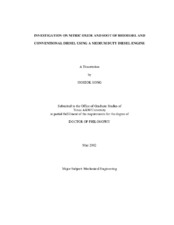| dc.description.abstract | Biodiesel has been suggested as an alternative fuel to the petroleum diesel fuel. It beneficially reduces regulated emission gases, but increases NOx (nitric oxide and nitrogen dioxide) Thus, the increase in NOx is the barrier for potential growth of the biodiesel fuel. In general, NOx formation is dominated by flame temperature. Interestingly, soot can play a role as a heat sink as well as a heat transfer media to high temperature gases. Thus, the cooling effect of soot may change the flame temperature and therefore, NOx emissions.
In this study, emphasis is placed on the relationship between soot and NO (Nitric oxide) formation. For the experimental study, a metallic fuel additive is used since barium is known to be effective to suppress soot formation during combustion. The barium additive is applied to #2D (Number 2 diesel fuel) by volume basis: 0.1, 0.25 and 0.5 %-v, and to the palm olein oil by 0.25 %-v. All the tests are carried out in a four-cylinder medium duty diesel engine, 4045 DI diesel engine, manufactured by John Deere. For the analysis, an analytical model is used to estimate combustion temperature, NO concentration and soot emissivity.
The results show that NO concentration does not have the expected trade-off relation with soot. Rather, NO concentration is found to be more strongly affected by ambient temperature and combustion characteristics than by soot. The results of the analytical model show the reasonable NO estimation and the improvement on temperature calculation. However, the model is not able to explain the detailed changes of soot emissivity by the different fuels since the emissivity correlation is developed empirically for diesel fuel. | en |


